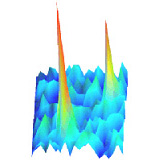Ever wondered how cells react when you fly them at 20g? Indeed they change their mechanical and other properties. This experiment, driven by Julia, is a ramp-up to our experiment flying on ISS.
Hypergravity affects Cell Traction Forces of Fibroblasts
J. Eckert, J. J.W.A. van Loon, L. M. Eng, T. Schmidt
Cells sense and react on changes of the mechanical properties of their environment, and likewise respond to external mechanical stress applied to them. Whether the gravitational field, as overall body force, modulates cellular behavior is however unclear. Different studies demonstrated that micro- and hypergravity influences the shape and elasticity of cells, initiate cytoskeleton reorganization, and influence cell motility. All these cellular properties are interconnected, and contribute to forces that cells apply on their surrounding microenvironment. Yet, studies that investigated changes of cell traction forces under hypergravity conditions are scarce. Here we performed hypergravity experiments on 3T3 fibroblast cells using the Large Diameter Centrifuge at the European Space and Technology Centre (ESA-ESTEC). cells were exposed to hypergravity of up to 19.5g for 16 h in both the upright and the inverted orientation with respect to the g-force vector. We observed a decrease in cellular traction forces when the gravitational field was increased up to 5.4g, followed by an increase of traction forces for higher gravity fields up to 19.5g independent of the orientation of the gravity vector. We attribute the switch in cellular response to shear-thinning at low g-forces, followed by significant rearrangement and enforcement of the cytoskeleton at high g-forces.

